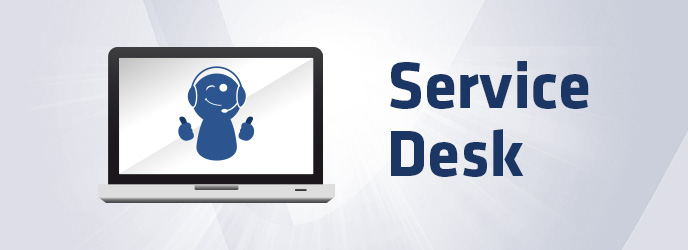According to the Information Technology Infrastructure Library (ITIL), an enterprise service desk comes as the primary IT function within the IT Service management. The main motive or intent for creating such an IT function is to create a Single Point of Contact (SPOC) for communication between the user and the IT staff.
Why is Service Desk important for an IT Organization?
Every organization tends to have its own implementation of a central point that is used to handle the customers and the users. Those IT Enterprise Service Desk facilities help maintain a good life cycle for the organization to manage their workflow.
The service desk is also responsible for managing the majority of the tasks that are happening on an everyday basis in a company. They will also have the responsibility to collect and revert for feedbacks. A right Service Desk Management System will be capable of monitoring the customer systems and report on a daily basis. Enterprise Service Desk will have the capability of resolving issues reported their own or else they will forward the ticket to the respective department, making the customer experience better.
How the Service Desk and Help Desk differ?
Both Service Desk and Help Desk differ in many cases and even they have got some similarities too. For an enterprise, we can say, “A help desk focus on end-user needs and whereas service desk focus on corporate strategy”.
A help desk is mainly concerned for the end-user, and it always keeps a database to track down the IT assets on a real-time basis. ITIL refers to the help desk as a limited kind of service desk, which means they can only provide a portion of the work done by the service desk.
Enterprise Service desk has a broad area to cover, providing services that are being done by the help desk and the other services they are abiding to perform, just like the activities mentioned in the article earlier. A global service desk has to take accountability for facilitating the integration of business.
How can it be classified?
The type of service desk used by the company varies with their service. Each of the enterprises will have their own tailored enterprise service desk management facilities and those that are capable of handling different activities. There are specific activities or functions that the service desk is accountable for, some of them are
Ø Incident Management
Ø Problem Management
Ø Configuration Management
Ø Release Management
Ø Database Maintenance
Ø Security Management

Let’s look at the differences between them in detail:
- The Service Desk is completely process focused and aims to get everything within the ITIL guidelines. In contrast, the help desk is support focused, and it’s only aimed at keeping customers happy.
- The Service Desk utilizes process and software to reduce the service interruption happened both proactively and reactively, In contrast the help desk uses a knowledge base and solutions to answer support questions.
- Help Desk intending on incident management and always tend to focus on getting customer queries serviced at the point of contact. They act as a responsible authority of an incident from start to end and process the request as per priority and availability.
On the other hand, Enterprise Service Desk provides a broad area of functions, which includes incident management that was handled by the service desk. They provide a more strategic approach to the IT infrastructure and not like the way the help desk does only when the issue is raised.
- Help Desk act as Single Point of Contact (SPOC) for IT support. It means the issues raised for IT support are handled quickly and efficiently by the help desk for the end-users. But they lack the capability of controlling other service applications and business processes.
Service Desk also acts as Single Point of Contact (SPOC), but unlike help desk, they act as contact point not just for IT support, but for all IT areas, applications, and businesses, which is why help desk is called as only a portion of the service desk. - Help Desk has got only limited integration with other processes by the IT Management team, which is one of the main things that differentiate it from the service desk. The limited integration to other department processes is the main reason every organization tends to put resources on building an enterprise service desk for them.
Service desks integrate with each and every process, which are done by the IT Management team, making it a more reliable desk for information on anything and everything. No process in an organization would pass without the knowledge of the service desk.
- Help Desk can’t negotiate service level agreements with the customers, which comes within the service level management.
Service desk possess service level management and are capable of negotiating service level agreements and schedule services according to the targets set. They are also responsible for ensuring all operational agreements are appropriate. - Service Desk has the feature of release and problem management. With the help of a problem database, use it to identify and track problems and identify the workarounds with them. Once they identify the problem and resolve it, they are marked as “known error.”
Other than acting as an SPOC, the help desk can’t identify and track the problem from the database and report.
So is it necessary to have a service desk for every organization?
I will say it depends. It is not mandatory; there are fewer companies with a service desk without help desk, but many companies have just a help desk.
Future of IT Service Desk?
The service desk is a standard necessity for a business to operate efficiently in a fast-paced environment, but the demands from the technological entrepreneurs and the end-users demand more from an IT department and the service they provide. These expectations give wings to a better future of service desk management systems.

IT Help Desk
The Help Desk is mostly considered as a SPOC (Single Point of Contact) for IT Services. What users expect from a help desk is to quickly resolve the issues raised by them with a single point of contact.
A Help Desk is used to provide the customer or the user with information and support that the company is intended to provide. As the name implies, the IT Help Desk gives the users proper guidance for troubleshooting and rectifying the issues regarding products or services.
Contact Centre
A Contact Centre is a central point in an organization where the individual communications are managed and serviced. It also acts as a point in an enterprise where all the contacts are managed.
Call Center
As the name implies, a Call Center is a centralized office that uses computer automation to handle large volumes of incoming and outgoing telephones in big organizations. It can be either inbound or outbound based on the respective organization’s service or mode of operations.
Not just with the amount of service they can provide but also with the hands-on assistance from the technicians, make ITIL Service Desk a must in every organization. Customers are demanding a faster way of approach in resolving their issues and that too in a proper manner without making them wait for a long period of time. So implementing a service desk is also a matter of customer satisfaction.
The changes happening in the IT environment will bring radical change in the IT service desk management, not just how it works, but the way it will serve the people who take those services.
The features provided by the latest service desk make it more prominent in the future and all those big and small organizations that are finding it difficult to manage their day-to-day workflow will be forced to implement a service desk for their organization.
Why build your Service Desk with Vays Infotech?
Vays Infotech, a pioneer in providing IT Infrastructure Services in Bangalore, comes with a flexible and high performing managed enterprise service desk in Bangalore, that focuses on providing the end-users with the best customer support experience, which will eventually result in better IT infrastructure.

